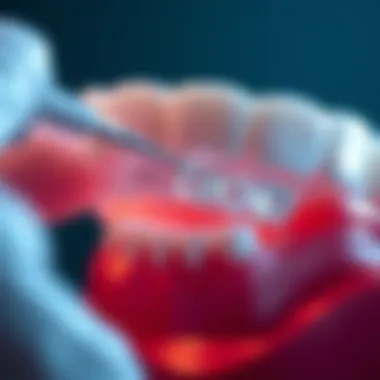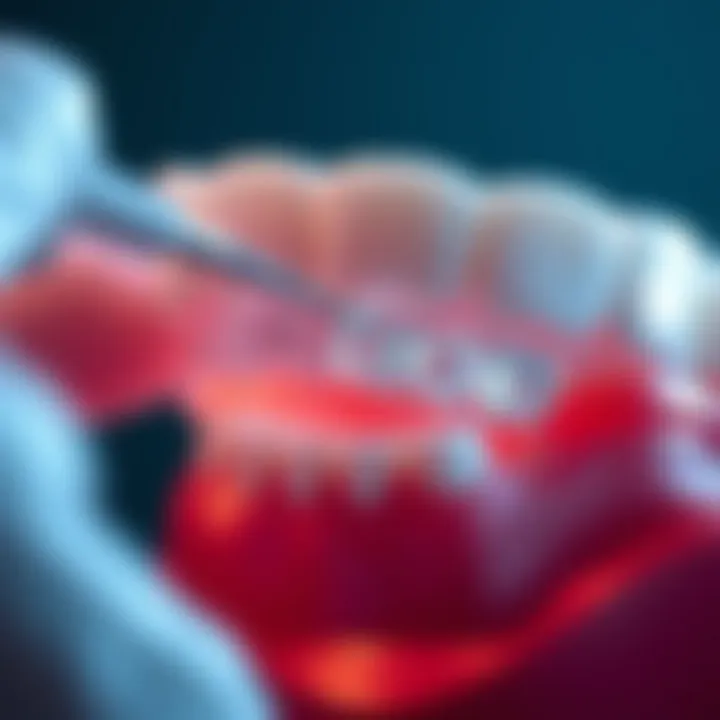Silver Diamine Fluoride: Comprehensive Overview


Intro
The landscape of dental care is ever-evolving, and at the forefront of discussions surrounding non-invasive treatments is silver diamine fluoride (SDF). This therapeutic agent has gained traction in recent years, offering a unique approach to managing dental caries, particularly in populations where traditional methods may not be as effective. The significance of SDF lies not only in its ability to halt the progression of tooth decay but also in its broader implications for dental practice and patient care.
SDF consists of a high concentration of silver and fluoride ions, which together work to strengthen tooth enamel and inhibit harmful bacteria. This combination allows SDF to play a dual role in both prevention and intervention. Understanding how SDF functions, its clinical application, and the considerations that practitioners must keep in mind is essential for any healthcare professional dedicated to cutting-edge dental care.
In this article, we seek to flesh out the intricacies of SDF, delving into its chemical composition, mechanisms of action, and real-world applications, providing a comprehensive overview that will resonate with students, researchers, educators, and professionals in the field.
Research Overview
Summary of Key Findings
Research indicates that the application of SDF can lead to a significant reduction in the incidence of caries, particularly in high-risk populations. Studies have shown that the treatment is both effective and efficient, requiring minimal application time while yielding consistent results across diverse patient demographics. Moreover, SDF is typically well-tolerated, making it a candidate for various clinical settings.
Background and Context
The dynamics of dental care have long been driven by a push towards minimally invasive approaches. SDF emerged as a response to the challenges posed by traditional restorative practices, such as drilling and filling. Its roots trace back to early 20th-century research, with significant advancements occurring over the past few decades. Its innovative nature reflects a paradigm shift in treating dental caries—targeting the source of decay rather than merely addressing the symptoms.
Clinicians can integrate SDF into their practice not only to enhance treatment outcomes but also to encourage a more holistic view of dental health. By recognizing the importance of non-invasive therapies, dental professionals can engage patients in meaningful conversations about preventive care, promoting awareness and education around oral health.
Foreword to Silver Diamine Fluoride
Silver diamine fluoride, often abbreviated as SDF, is a gathering storm in the world of dentistry, particularly when it comes to managing dental caries. The significance of SDF lies not only in its effective therapeutic properties but also in its potential to revolutionize how patients and practitioners approach treatment options. This introduction will shed light on what SDF is, its relevance in contemporary dental care, and why understanding it is crucial for students and professionals alike.
Definition and Composition
Silver diamine fluoride is essentially a colorless liquid that combines silver, fluoride, and ammonia. Each component plays an important role in its function. The silver acts as an antibacterial agent, combating the harmful bacteria that contribute to tooth decay. The fluoride helps to remineralize the tooth enamel, reinforcing the tooth's structure against future decay. Ammonia is used primarily to stabilize the mixture, making it easier to apply.
In simpler terms, it’s like a protective coat for your teeth. Imagine giving your teeth the extra armor they need to stay strong. It’s also worth noting that the composition can vary slightly based on the manufacturer. No matter the specifics, the key active ingredients remain the same, ensuring consistency in its effects.
Historical Context
The roots of silver diamine fluoride trace back to the early 20th century when it was initially used in Japan. Researchers recognized its antibacterial properties and potential as an effective treatment for cavities, particularly among pediatric populations. However, its use did not gain traction globally until relatively recently when dental practitioners began to explore more conservative, non-invasive approaches to dental health.
In the 21st century, as dental practices evolved and emphasized prevention over intervention, SDF found its place within the professional toolkit. Its return to popularity can be attributed to the changing landscape in dentistry, with practitioners increasingly seeking effective but less invasive methods to combat caries, especially in vulnerable populations such as children and elderly patients.
"Silver diamine fluoride is a testament to how innovation in dental care can lead to simpler, more effective treatment options that prioritize patient comfort and outcomes."
With its introduction into routine dental practice, SDF has generated discussions on ethical use, patient acceptance, and cost-effectiveness, all of which are crucial topics to explore further as we delve deeper into the mechanics and applications of silver diamine fluoride.
Mechanism of Action
Understanding the mechanism of action of silver diamine fluoride is crucial for its application in modern dentistry. It provides insight into how this compound operates at a molecular level, offering a more rounded view on its efficacy in managing dental caries and promoting oral health. Moreover, recognizing these processes equips dental professionals with the knowledge necessary to explain treatment options to patients and address any concerns they might have.
Chemical Properties
Silver diamine fluoride, often abbreviated as SDF, consists mainly of silver ions and fluoride ions suspended in a solution. The silver ions are notable for their antibacterial properties, inhibiting the growth of bacteria that contribute to tooth decay. When SDF is applied to a carious lesion, a complex interaction occurs. The fluoride ions enhance the remineralization of the tooth structure, while the silver ions work to kill pathogenic bacteria.
A key element of SDF’s chemical properties is its ability to form various compounds with calcium and phosphorus. These compounds create a barrier on the tooth surface, which not only helps in arresting the decay process but also contributes to reducing pain associated with carious lesions. Essentially, the combination of these properties means that SDF tackles tooth decay from multiple angles, which is particularly beneficial in pediatric dentistry where traditional drilling and filling may be more challenging.
Interaction with Dental Hard Tissues
The interaction of SDF with dental hard tissues is fascinating and quite pivotal to its effectiveness. After application, SDF penetrates the demineralized areas of the tooth, significantly changing the biomechanical properties of the dentin and enamel. This interaction leads to a phenomenon known as silver phosphate formation, enhancing the structural integrity of the tooth.
The observed increase in hardness in treated areas can be attributed to mineralization, where fluoride aids in replacing lost calcium and phosphate ions within the tooth. This process creates what many researchers refer to as a 'reinforced mineral matrix.'
"The use of silver diamine fluoride transforms the approach to caries treatment, making it both effective and patient friendly."
However, it is important to consider a few limitations when discussing SDF's interaction with dental tissues. While its advantages are significant, SDF does stain teeth due to its silver content, which some patients find undesirable. As such, context matters—practitioners should weigh the benefits against patient preferences. The nuanced understanding of how SDF functions clarifies why many in the dental field are enthusiastic about its applications.


In summary, the mechanism of action of silver diamine fluoride showcases the compound’s multifaceted approach to caries management in dentistry. Gaining a thorough grasp of its chemical properties and how it interacts with dental hard tissues is imperative for maximizing its clinical benefits.
Clinical Applications
The realm of dental care is quite diverse, with various methodologies employed to manage oral health effectively. One of the more groundbreaking strategies in recent years involves the use of silver diamine fluoride (SDF). This treatment not only shows promise in combating tooth decay but also opens doors for non-invasive interventions that align with modern dental practices. Understanding the specific clinical applications of SDF is essential to appreciate its role in the landscape of contemporary dentistry.
Use in Caries Management
Caries, or tooth decay, continues to be a significant concern across populations, affecting both young and old alike. SDF acts as a preventive agent by arresting the progress of carious lesions. When applied to decayed teeth, it works through a mechanism where silver ions inhibit bacterial growth, offering a potent defense against the further deterioration of dental tissue. Furthermore, the fluoride component helps to remineralize and strengthen the tooth structure.
Imagine a child whose dental fears prevent them from obtaining traditional fillings. SDF provides a viable alternative, sparing the child from multiple visits and the anxiety often associated with drilling and injections. It can be comfortably applied in a single session, transforming what could be a distressing experience into a more manageable one. The implications for this are wide, particularly for high-risk groups such as children or the elderly, who may be less suited to undergo invasive procedures.
Health practitioners have noted that SDF not only halts decay in its tracks but can sometimes reverse early lesions, leading to improved outcomes for patients. A significant aspect of SDF’s advantage in caries management is its ease of application, allowing for a swift, painless experience.
Indications for Use
While SDF presents numerous benefits, it is crucial to identify the circumstances under which its use is particularly indicated. Here are some factors that clinicians typically consider:
- Active Carious Lesions: SDF is best suited for teeth exhibiting active decay. It's not meant to replace conventional restorative methods for deeply affected teeth but can effectively manage initial to moderate carious lesions.
- High Caries Risk Patients: Individuals with high susceptibility to caries—be it due to socioeconomic factors, dietary habits, or existing medical conditions—can greatly benefit from SDF applications.
- Behavioral Challenges: Patients who experience anxiety or phobia related to dental treatment can find SDF an excellent option. Since it’s non-invasive and quick, it aligns well with those who would otherwise refuse treatment.
- Pediatric Dentistry: Children often resist traditional restorative methods, making SDF an enticing choice. Its ability to halt decay minimizes the number of times a child would need to undergo dental procedures.
- Elderly and Special Needs Patients: Older adults or individuals with disabilities may also find SDF advantageous. Many of these patients frequently face challenges accessing traditional dental services, and SDF provides a solution that can be administered rather conveniently.
In summary, the clinical applications of silver diamine fluoride reflect its potential as a transformative agent in dental caries management. SDF addresses the needs of a diverse patient population while offering a pathway toward effective, non-invasive treatments in dental practice.
"The application of SDF opens new frontiers in patient-centered dental care, emphasizing prevention over repair."
By thoughtfully incorporating SDF into treatment plans, dental professionals can harness this innovative material to improve patient outcomes significantly. The evolving landscape of dentistry leans towards minimally invasive strategies, and SDF is a notable example leading this movement forward.
Advantages of Silver Diamine Fluoride
Silver diamine fluoride offers various advantages that make it a noteworthy consideration in modern dental practices. As dental professionals seek effective methods to manage caries without invasive procedures, SDF emerges as a compelling option. This section delves into specific elements that underscore its importance, focusing on the benefits of non-invasive treatment as well as its cost-effectiveness.
Non-Invasive Treatment
One of the most striking advantages of silver diamine fluoride is its non-invasive nature. Traditional treatments for dental caries often require drilling and filling, which many patients, especially children, find daunting. In contrast, SDF can be applied quickly and painlessly to affected areas, offering a simple solution that usually does not require anesthesia. This can be particularly beneficial for patients with dental anxiety or those who are unable to tolerate more invasive options due to health issues.
The application process itself is straightforward. The dentist simply cleans the tooth surface and applies SDF with a brush or microbrush. This can usually be done in one sitting, minimizing the time spent in the dental chair and reducing stress associated with frequent dental visits. The effectiveness of SDF in arresting caries progression can often be observed within weeks, providing a rapid solution for dental decay management.
Moreover, SDF is not limited to pediatric use; adults, especially those with advanced decay or underlying health conditions that complicate traditional treatments, can also benefit from its application. Patients who might not have otherwise considered treatment due to past traumas may respond favorably to the gentler approach SDF represents.
SDF represents a paradigm shift in dental care, emphasizing preservation over intervention, making it a powerful tool in the hands of dental professionals.
Cost-Effectiveness
Cost is a significant concern in both personal and public health sectors. Silver diamine fluoride presents a cost-effective alternative to standard restorative treatments. The price tag associated with traditional methods, including materials and labor, can accumulate quickly, placing a burden on both patients and healthcare systems.
In contrast, SDF is relatively inexpensive when compared to conventional procedures such as fillings or crowns. Not only does the material itself cost less, but the simplified application process often means reduced chair time, translating directly to lower labor costs. For practices that prioritize efficiency, SDF reduces overhead without compromising care quality.
Furthermore, the potential for SDF to prevent future decay can result in significant long-term savings in treatment costs, as it helps mitigate the need for more extensive and costly interventions down the road.
In public health contexts, the cost savings are even more pronounced. Communities with high rates of dental caries can benefit from implementing SDF programs that reduce the overall treatment burden, allowing for better allocation of resources and reaching more patients. These aspects make silver diamine fluoride an appealing choice not just for individual practices but also for broader health initiatives focused on improving dental health at the population level.
In summary, silver diamine fluoride stands out due to its non-invasive treatment approach and cost-effectiveness, making it a valuable option in the arsenal against dental caries. By utilizing SDF, dental professionals can enhance patient comfort and reduce treatment costs, further promoting access to essential care.
Limitations and Considerations
When integrating silver diamine fluoride (SDF) into contemporary dental practice, it is vital to address its limitations and considerations. These factors can profoundly influence treatment outcomes and patient care. While SDF presents innovative benefits in caries management, understanding its potential drawbacks is essential for practitioners seeking to make informed decisions in clinical settings. This section explores these critical aspects, including potential side effects and patient acceptance issues, ensuring a holistic view of SDF's role in dentistry.
Potential Side Effects
The application of silver diamine fluoride is not without its share of side effects. Most notably, dark staining of the tooth surface can occur where SDF is applied. This is a result of the chemical interaction between SDF and dental tissues, leading to a reaction that darkens both carious and non-carious surfaces. While this staining may be considered a cosmetic concern by some patients, it is important to note that the discoloration is typically superficial and does not impact the overall integrity of the tooth structure.
In addition to staining, there are other potential reactions to consider. Some individuals may experience temporary irritation of the gums or soft tissues in the mouth following treatment. These reactions usually resolve quickly and do not necessitate any further intervention.


Moreover, there’s the risk of allergic reactions, although they are relatively rare. Symptoms could manifest as a rash or localized swelling, which may necessitate discontinuation of SDF use in affected patients. Hence, dentists should be diligent in assessing each patient's history and performing patch tests when necessary.
"Recognizing and understanding the limitations associated with silver diamine fluoride is critical for optimizing treatment outcomes."
Patient Acceptance Issues
Despite its advantages, the acceptance of silver diamine fluoride by patients can vary significantly. Educating patients about the benefits and limitations is crucial in overcoming resistance. Many individuals may have preconceived notions about dental treatments and may feel hesitant to embrace a non-traditional method like SDF.
Cultural factors also play a role in shaping patient perceptions. In some communities, there exists a strong preference for more conventional treatments, such as fillings or crowns, which seem more aligned with their understanding of dental care. The perception that SDF is an alternative to traditional treatments can create apprehension.
Furthermore, the visible staining associated with SDF can lead to dissatisfaction among aesthetic-minded patients. Explaining that while the treatment is effective for halting decay, the resulting discoloration can be managed or minimized may help alleviate concerns. Building a rapport and fostering open conversations about the treatment plan can lead to better acceptance and cooperation from patients.
Comparative Analysis with Other Treatments
The role of silver diamine fluoride (SDF) in dental care has opened avenues for comparing it with other treatment modalities. It’s essential to approach such comparisons with an understanding of their individual benefits and limitations, especially within the context of caries management, a focal point in dentistry. This section examines how SDF stacks up against fluoride varnishes and traditional restorative methods, providing insight into the best practices for practitioners and patients alike.
Fluoride Varnishes
Fluoride varnishes have long been a staple in preventive dentistry, known primarily for their ability to remineralize enamel and provide a protective coating against cavities. These varnishes contain concentrated fluoride, which is applied directly to the teeth, making it a convenient option for many practitioners.
Key Benefits of Fluoride Varnishes:
- Ease of Application: Fluoride varnishes can be quickly applied in a dental setting and require minimal patient cooperation.
- Immediate Protection: They give a quick fluoride boost to the enamel surface, helping in the fight against early carious lesions.
- Fleeting Treatment: This method can be repeated several times a year based on the patient's caries risk and needs.
However, fluoride varnishes also have limitations when compared to SDF. While they provide essential fluoride to strengthen the enamel, they do not halt existing carious processes as effectively as silver diamine fluoride does. SDF has a unique mechanism that arrests the progression of cavities through the antibacterial properties of silver ions, making it not just preventive but also therapeutic.
"Fluoride varnish offers immediate protection, but SDF can turn the tide on existing decay rather than simply shield against it."
Traditional Restorative Methods
Traditional restorative methods, often associated with fillings or crowns, involve surgical intervention to treat existing decay. While such procedures are well-established and provide effective results in many cases, they also come with significant drawbacks.
Considerations of Traditional Restorative Methods:
- Invasiveness: These methods often involve removing healthy tooth structure to access cavities, which can lead to further complications down the line.
- Time-consuming: Restorative procedures can be lengthy, requiring more time in the dental chair and follow-up visits for repairs or adjustments.
- Cost Implications: The financial burden of fillings, crowns, and related procedures can be considerable, making restorative dentistry less accessible for some patients.
In contrast, SDF emerges as a non-invasive, cost-effective alternative. By using SDF, dentists can manage carious lesions without the need for drilling or anesthesia, making it particularly compelling for young patients or those with special needs who may experience anxiety during more invasive procedures. Moreover, it has been shown to be effective in various populations, including those with limited access to dental care.
In sum, while each treatment method has its merits, incorporating SDF into the arsenal of dental care approaches ensures a comprehensive strategy that emphasizes preservation of tooth structure and patient-centered care. By understanding these differences, practitioners can make informed decisions that best suit individual patient needs.
Regulatory Status and Recommendations
Understanding the regulatory landscape surrounding silver diamine fluoride is crucial for dental practitioners. The importance of this topic cannot be overstated; it provides clarity on how SDF is positioned within the dental care protocol and its acceptance among healthcare professionals. Regulatory approvals ensure that the product meets safety standards and efficacy measures, which can directly influence treatment options available to patients. Moreover, clinical guidelines offer a framework for integrating SDF into daily practice while addressing ethical considerations that may arise.
Regulatory Approvals
Silver diamine fluoride has garnered quite a bit of attention, and with that comes a flurry of scrutiny from regulatory bodies. In the United States, the path for SDF approval began with its designation by the FDA as a Device, rather than a drug; this categorization can sometimes affect how dental health professionals utilize it. It's critical to acknowledge that the FDA granted its approval based on studies demonstrating that SDF is effective in stopping cavity progression and is safe for human use. This decision lends credence to the use of SDF in clinical settings, boosting confidence among practitioners tackling caries management.
Notably, countries differ in their regulatory approaches. In Canada, for instance, SDF was approved through Health Canada, which focused heavily on its efficacy in providing a non-invasive option for treating dental caries among various demographics. Consequently, understanding local approvals can be quite a task due to varying requirements and standards across borders.
- Key Points on Regulatory Approvals:
- FDA Classification: SDF is categorized as a device, influencing its use.
- International Regulations: Different countries like Canada and European nations have their own approving bodies that assess safety and effectiveness.
- Impact on Practice: Regulatory backing can enhance clinicians' trust in incorporating SDF into their practices.
Clinical Guidelines
As we dissect the clinical guidelines surrounding silver diamine fluoride, it becomes evident that these recommendations serve as the backbone of SDF usage in dental practice. The guidelines are formulated based on empirical evidence and expert consensus, playing an essential role in how practitioners decide to approach caries management.
They recommend assessing patients holistically—considering age, overall health, and dental history—before applying SDF. It is particularly emphasized for high-risk groups, including children and the elderly, due to their increased susceptibility to cavities and limited access to traditional dental treatments. Adding to the complexity, the guidelines stress the importance of informed consent, as communicating the benefits and potential side effects to patients or their guardians is paramount.
- Essential Elements of Clinical Guidelines:


- Patient Assessment: Analyze factors that influence caries risk.
- Informed Consent: Clear communication regarding SDF's function and possible consequences.
- Strategies for Use: Guidelines suggest SDF should be part of a broader dental care strategy, integrating it with other interventions as needed.
The promise of silver diamine fluoride in transforming caries management is steadily clear, yet its application must be approached thoughtfully within the framework of regulatory status and clinical recommendations.
In summary, both regulatory approvals and clinical guidelines work hand in hand to ensure that practitioners can safely and effectively incorporate SDF into their treatment arsenal. As researchers continue to explore its potential, the real-world experiences of dental professionals will shape the ongoing dialogue about SDF's role in dental care, laying the groundwork for future discussions and innovations in the field.
Future Directions in Research
The landscape of dental treatments is ever-evolving, and the future directions in research regarding Silver Diamine Fluoride (SDF) promise to be both intriguing and significant. As more dental professionals and researchers focus on non-invasive methodologies, SDF stands at the forefront of change. Growing evidence supports its effective use in various dental scenarios, making it essential to explore its uncharted potential. Future investigations can pave new paths for integrating SDF in clinical settings, enhancing its benefits while addressing its limitations.
Innovation in Treatment Techniques
Continuing advancements in treatment techniques involving Silver Diamine Fluoride may lead to groundbreaking applications. The exploration of SDF combined with other agents could enhance its effectiveness and longevity in cavity management. For instance, researchers could investigate the potential of incorporating antibacterial agents or higher concentrations of fluoride to further bolster its anti-caries efficacy.
Moreover, incorporating laser technology might enhance the delivery and penetration of SDF into the tooth structure. This can make treatment not only more effective but also faster and less invasive, which can be a game-changer in how dental care is delivered. Additionally, innovative application methods, such as the use of specially designed applicators, could minimize patient discomfort and improve the precision of SDF application.
"The ongoing research into SDF application techniques may redefine how dental professionals approach the prevention and treatment of caries, prioritizing patient comfort and outcomes."
Long-Term Studies and Outcomes
While the short-term benefits of Silver Diamine Fluoride are increasingly understood, long-term studies remain essential for grasping its full impact on dental health. Research focusing on patient outcomes over several years will help clarify the durability of the treatment, giving insight into how SDF affects overall dental health over time.
Key areas of interest for long-term studies might include:
- The longevity of SDF effects: Monitoring how effectively SDF can prevent cavity progression years post-application compared to traditional methods.
- Re-mineralization potential: Assessing how well teeth treated with SDF may remineralize compared to untreated areas after prolonged exposure.
- Patient satisfaction: Evaluating how patients perceive their dental health and satisfaction with SDF treatments in long-term scenarios engages their perspectives and informs future practices.
Such studies will not only provide vital data to validate the clinical effectiveness of SDF over time, but they will also serve as a foundation for developing best practices in its application. By embracing a meticulous approach to understanding SDF's influence on long-term dental health, the dental community can ensure that treatments remain beneficial and scientifically sound.
Patient Education and Consent
Patient education and consent form a crucial part of the conversation surrounding silver diamine fluoride (SDF) in modern dentistry. As this innovative treatment offers unique benefits, it also raises important considerations that dental professionals must navigate with their patients. The necessity of thorough education is not merely a procedural formality; it plays a pivotal role in empowering patients to make informed choices about their dental health.
Informing Patients about SDF
When introducing SDF as a treatment option, it's essential to walk patients through its benefits and how it works. Most people may not have heard about SDF before, so starting with a simple definition can be helpful. SDF is a topical, colorless solution that helps manage dental caries by slowing or halting the decay process. Explaining that SDF contains silver and fluoride—which have known antibacterial properties—can clarify its effectiveness against cavities.
Moreover, discussing the procedure in detail can alleviate anxiety. Patients should understand that the application is quick and non-invasive, involving just a few moments in the dental chair. Showing visual aids or diagrams can enhance comprehension further. Some may ask about the implications of its dark staining effect on cavities; clear communication about this is necessary as well. Explain that while SDF can cause discoloration of carious lesions, it does not stain healthy tooth structure, making it an effective choice for treating specific areas without compromising the integrity of surrounding teeth.
In addition, providing literature that patients can take home helps reinforce the conversation. This could include handouts containing frequently asked questions or further reading on the subject. Offering links to reputable sources, such as the American Dental Association or National Institute of Dental and Craniofacial Research, would serve as excellent supplementary material for patients who wish to explore more.
Ethical Considerations
Ethical considerations are another layer that must be meticulously addressed during discussions about SDF. The practice of informed consent hinges on respect for patient autonomy; patients should feel confident that they can voice concerns or ask questions without feeling rushed. Societal shifts towards patient-centered care emphasize the importance of this practice.
First and foremost, dental professionals should assess the patient's understanding of SDF and its implications before proceeding. This invites an open dialogue—encouraging patients to express their feelings about potential outcomes lets them engage in the decision-making process. It’s vital to ensure that they are aware of all available alternatives, including traditional methods of treating caries. This transparency aligns with ethical principles, fostering trust between the patient and provider.
Furthermore, instructions for aftercare following SDF application should be clearly communicated, as this directly impacts the treatment's success. Patients must understand that while SDF is effective, good oral hygiene practices remain paramount. Failure to follow aftercare recommendations could lead to treatment failure, giving rise to the ethical dilemma of whether the provider has adequately prepared the patient.
Adhering to ethical principles not only enhances patient care but also helps build a practice's reputation. Being open about potential side effects, costs, and treatment success rates can prevent future misunderstandings. Therefore, when navigating this complex landscape, dental professionals must remain vigilant in not only informing but also allowing patients to express their preferences and concerns.
Ultimately, patient education and consent serve as cornerstones for successful treatment outcomes in the use of silver diamine fluoride. Engaging patients in meaningful dialogue ensures they are well-informed partners in their care.
Finale
As we draw our exploration of silver diamine fluoride (SDF) to a close, it’s crucial to look at the broader implications of this treatment within the dental field. The relevance of SDF cannot be overstated; its ability to halt the progression of dental caries provides a significant lifeline, particularly for high-risk populations. Where traditional interventions may fall short, SDF stands as a beacon of hope, presenting a non-invasive, cost-effective alternative that aligns with modern dental practices focusing on preventive care.
This section aims to encapsulate the main points of our discussion while also hinting at how these insights can shape future practices in dentistry.
Recap of Key Points
- What is SDF?: A powerful agent comprised primarily of silver and fluoride, used extensively in managing dental caries.
- Mechanism of Action: SDF works by binding to dentin to inhibit bacterial growth and help remineralize the tooth structure.
- Applications: Widely utilized in pediatric dentistry but extending its reach to adult patients and special populations is gaining traction.
- Advantages: The non-invasive nature of SDF treatments makes them suitable for those who may resist traditional treatment methods, such as fillings or crowns.
- Considerations: Despite its advantages, it’s important to discuss potential side effects and patient acceptance issues connected with SDF.
Implications for Future Practice
The implications of integrating SDF into routine practice are profound. Firstly, its increasing acceptance in dentistry might lead to a paradigm shift in how we approach caries management. Given its affordability, SDF could democratize dental care, making it more accessible for underserved communities.
Furthermore, long-term studies are essential to fully understand the sustainability of SDF’s effects on children's oral health as well as in other demographic groups. Encouraging research into different formulations and combinations with other preventive agents could enhance its efficacy and widen its applications.







